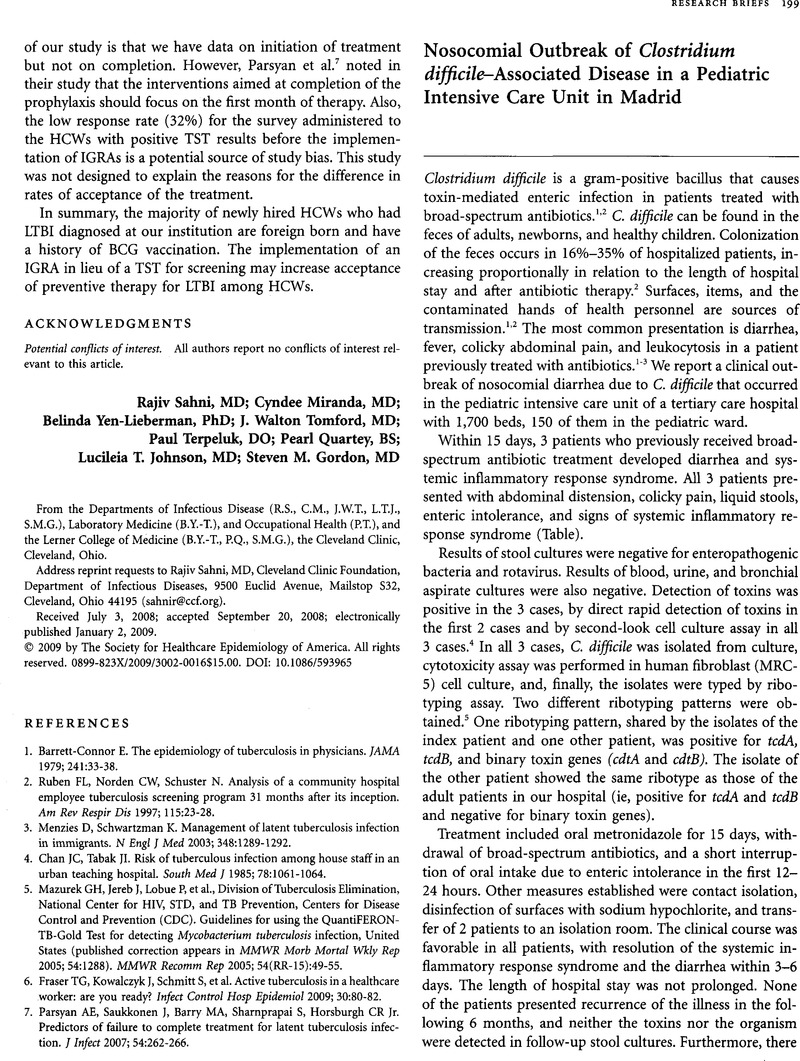Crossref Citations
This article has been cited by the following publications. This list is generated based on data provided by
Crossref.
Botrán, Marta
José Solana, M.a
and
Bustinza, Amaya
2010.
Infecciones nosocomiales (II). Otras infecciones.
Anales de Pediatría Continuada,
Vol. 8,
Issue. 4,
p.
174.
Marsh, Jane W.
O'Leary, Mary M.
Shutt, Kathleen A.
Sambol, Susan P.
Johnson, Stuart
Gerding, Dale N.
and
Harrison, Lee H.
2010.
Multilocus Variable-Number Tandem-Repeat Analysis and Multilocus Sequence Typing Reveal Genetic Relationships among
Clostridium difficile
Isolates Genotyped by Restriction Endonuclease Analysis
.
Journal of Clinical Microbiology,
Vol. 48,
Issue. 2,
p.
412.
Castillo, A.
López, J.
Panadero, E.
Cerdá, J.
Padilla, B.
and
Bustinza, A.
2012.
Conservative surgical treatment for toxic megacolon due to Clostridium difficile infection in a transplanted pediatric patient.
Transplant Infectious Disease,
Vol. 14,
Issue. 4,
Asensio, Angel
and
Monge, Diana
2012.
Epidemiología de la infección por Clostridium difficile en España.
Enfermedades Infecciosas y Microbiología Clínica,
Vol. 30,
Issue. 6,
p.
333.
Warrack, Simone
Duster, Megan
Van Hoof, Sarah
Schmitz, Michelle
and
Safdar, Nasia
2014.
Clostridium difficile in a children's hospital: Assessment of environmental contamination.
American Journal of Infection Control,
Vol. 42,
Issue. 7,
p.
802.
Mc Laughlin, D.
Friedmacher, F.
and
Puri, P.
2014.
The impact of Clostridium difficile on paediatric surgical practice: a systematic review.
Pediatric Surgery International,
Vol. 30,
Issue. 8,
p.
853.
Solana, María José
Bustinza, Amaya
López, Jorge
and
López-Herce, Jesús
2021.
Clostridiodes difficile associated disease risk and proton pump inhibitors in critically ill children.
Enfermedades infecciosas y microbiologia clinica (English ed.),
Vol. 39,
Issue. 3,
p.
160.
Solana, María José
Bustinza, Amaya
López, Jorge
and
López-Herce, Jesús
2021.
Clostridiodes difficile associated disease risk and proton pump inhibitors in critically ill children.
Enfermedades Infecciosas y Microbiología Clínica,
Vol. 39,
Issue. 3,
p.
160.
Watkin, Sam
Yongblah, Francis
Burton, James
Hartley, John C.
and
Cloutman-Green, Elaine
2024.
Clostridioides difficile detection and infection in children: are they just small adults?.
Journal of Medical Microbiology
,
Vol. 73,
Issue. 3,





